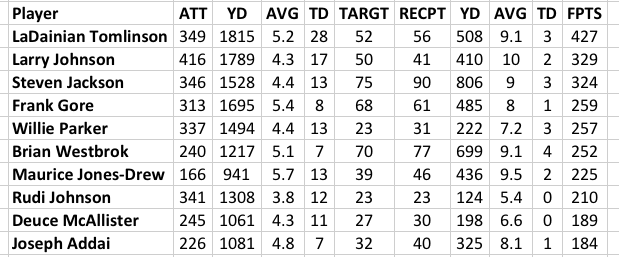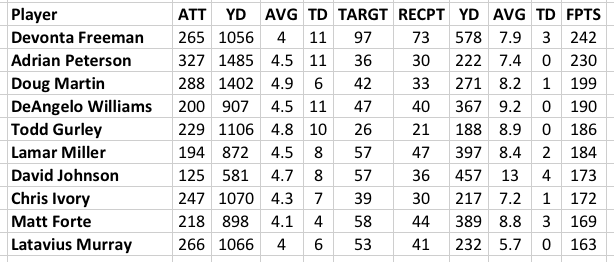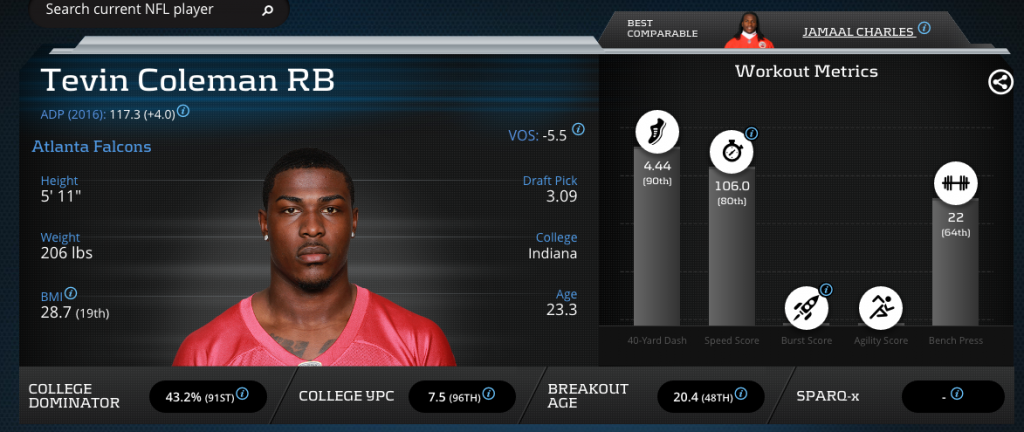Flashback
It is time for a flashback. The year is 2006. Below is a list of the top ten running backs in fantasy football standards leagues that season. Please note the rushing attempts and total fantasy points for each player. Now fast forward to 2015, exactly ten years later. Here are the top ten running backs in standard scoring leagues from last year. Again, note the rushing attempts and total fantasy points per player.
The fantasy running back narrative has clearly changed. In 2006, there were actually nine players with over 300 carries, including the illustrious Chester Taylor (bonus points if you can name his team). In 2015? Just one, Adrian Peterson. In 2006, there were 26 running backs with over 200 carries. In 2015? Only 15. Despite this huge change, fantasy football drafters still evaluate running backs by the same traditional metrics: yards, receptions, and touchdowns. If the running back position has changed, then shouldn’t the running back evaluative metrics change accordingly?
What Metrics Should I Examine?
Listed below are the three most important advanced metrics that should be used in evaluating your running back targets in this year’s fantasy draft. They are: Snap Share, Opportunity Share and Production Premium. I will explain each and provide you with my top takeaways from each metric. Finally, I will list the three best running back values for the 2016 season, regardless of league format.
Snap Share
Snap Share signifies the percentage of offensive plays that player was on the field. This does not include games the player was hurt and unavailable, it is simply a percentage of the games actually played. Here are my top takeaways from the 2015 Snap Share rankings:
- If you draft Le’Veon Bell (86.5-percent) and successfully execute the DeAngelo Williams (89.1-percent) handcuff, you will have outstanding RB production all year long. Both players ranked in the top two of all running backs in Snap Share.
- The only reason to avoid drafting Jamaal Charles (84.3-percent) is if you believe he will get injured. If he plays at least 14 games, he is a lock for a top 10 RB. Even if the Chiefs reduce his workload, he had the third best snap share in 2015.
- Do not underestimate the running back position in a Marc Trestman offense. Baltimore Ravens’ running back Justin Forsett had a 77-percent snap share, which reflects his run and catch abilities. He is wonderful value at his current RB32 drafting position
- Tevin Coleman (63.8-percent) was on the field a lot more than people realize. All this and while Devonta Freeman was the number one running back in fantasy football. Atlanta Falcons head coach Dan Quinn has already talked about increasing Coleman’s workload. His current ADP is RB40.
- Frank Gore (63.3-percent) may be 33 years old, but with Robert Turbin having problems, he is a clear RB1 if healthy. Rookie Josh Ferguson also becomes a must have handcuff in late rounds.
- Doug Martin was the second leading rusher in the NFL in 2015, yet only played 57.1-percent of the snaps. I have no interest in Martin, but strong interest in Charles Sims, with a snap share of only 38.8-percent that promises to increase.
- Todd Gurley (55.10-percent) does not see the field when the Rams are behind and need to throw. This is bad news when he plays for a Los Angeles Rams’ team that could be behind most of the season. This is precisely why he is not the top running back off my board. Should he even be number two?
- Duke Johnson was the RB34 in standard scoring leagues and RB23 in PPR leagues. He only played 50.9-percent of the snaps. With Hue Jackson as his head coach, that total will rise dramatically, and his rankings should rise accordingly.
- James Starks (48.9-percent) is so much more than Eddie Lacy’s backup. Starts is the pass catching running back in Green Bay, and gets multiple drives as the lead rusher as well. He sees more snaps than anyone realizes. Starks is currently being drafted as an RB50.
Opportunity Share
Opportunity Share is one of my favorite advanced metrics. This represents the percentage of total team running back carries plus targets. Comparing Devonta Freeman and Tevin Coleman provides us the perfect example. Coleman had a snap share of 63.8-percent but only an opportunity share of 25.6-percent. This means he was either a decoy or blocker on most of his field opportunities. Freeman however, had an opportunity share of 73.4%. Translation? If he was on the field, he got the ball almost three quarters of the time. Here are my top takeaways from the 2015 Opportunity Share rankings:
- T.J. Yeldon had the second highest opportunity share (75.2-percent). This tells me Chris Ivory is fantastic value at his current ADP of 108.9 (RB35).
- Both Tim Hightower (61.2-percent) and Mark Ingram (59.3-percent) finished in the top 20 in Opportunity Share. The lead RB in the New Orleans’ offense is a very productive place to be.
- LeSean McCoy finished No. 5 (72.4-percent) in Opportunity Share. With Karlos Williams (32.4-percent) suspended for the first four games, McCoy being drafted outside the top 10 running backs is stealing.
- Justin Forsett had a 58.4-percent opportunity share to go along with his 13th ranked snap share of 77%. Marc Trestman + health = big fantasy season for Forsett.
- Sixth in Opportunity Share? Jonathan Stewart at 71.5-percent. Stewart is one of the few running back workhorses left in the NFL. His ADP? 86.25 and RB29.
- Marshawn Lynch was No. 9 in Opportunity Share at 71-percent. A critical question you should answer before draft day is: Do you think these opportunities now go to Thomas Rawls (45.9-percent), or will Seattle be a running back by committee (RBBC)? If you believe the latter, it is certainly hurts Rawls’ fantasy value.
- Frank Gore (33-years old) was third in opportunity share with 74.8%. The lead running back in the Colts’ offense will be featured. If you don’t believe in Gore, than make sure you look at the Colts’ rookie backup, Josh Ferguson (ADP 180.7).
Production Premium
Production Premium is my favorite advanced metric of all. This compares the outcome of all pass attempts, carries and targets to league-average outcomes in those exact same game situations (yard line, down, and distance). Positive values indicate that a player is more efficient than the average player, while negative values indicate that a player is less efficient than his peers with similar opportunities in similar situations. Production Premium also takes into account time remaining and game score to account for non-standard situations such as 2-minute drill and garbage time. Here are my top takeaways from the 2015 Production Premium rankings:
- The top two Production Premium ranked players were both New England Patriots: James White (+60.4) and Dion Lewis (+48.8). Passing is more efficient than rushing in the NFL. Over the last 11 seasons, running backs have averaged 7.9 yards per reception and 4.2 yards per rush — a staggering 3.7 yards per touch difference. While conducting his own RB analysis, Matt Kelley noticed that the most efficient running backs according to PlayerProfiler‘s Production Premium each year are highly active in the passing game from Darren Sproles in 2013 to Roy Helu in 2014 to Dion Lewis in 2015.
- David Johnson’s +43.3 Production Premium was fourth in the NFL for running backs. Without a doubt, he is a first round selection. I would take him over Todd Gurley.
- Theo Riddick (+42.7) was the No. 6 RB in Production Premium. Given his 46th ranked snap share (52.3-percent) and No. 66 rank Opportunity Share (30-percent), Riddick is clearly one of the most efficient running back in fantasy. In the Lions backfield, he is the one to own, especially at an ADP of 118.8.
- Keep doubting Danny Woodhead. He was No. 10 in Production Premium (+27.0). This explains why Woodhead’s 756 yards led all NFL running backs and his 81 receptions also led all NFL running backs. With Ken Whisenhunt returning as Chargers’ offensive coordinator, there will be a plethora of short passing attempts. In Whisenhunt’s only year in San Diego (2013), Philip Rivers had his highest completion percentage (69.5-percent) of his career. This bodes well for Woodhead.
- Melvin Gordon had the worst Production Premium (-47.5) of any starting running back in football. The San Diego Chargers’ offensive line woes definitely contributed to that number. Much like Woodhead, Gordon has a great opportunity.
- James Starks (+14.9) had a significantly higher Production Premium than Eddie Lacy (-6.3). One of the best kept secrets in fantasy football is how effective Starks is for the Packers.
- The top pass catching RBs score very well here: Lewis, Riddick, Woodhead, Shane Vereen (23.4), Bilal Powell (34.6), and Charles Sims (19.4). This is precisely why zero RB is the ideal strategy in 2016. You can find great running back production very late in drafts.
My Top-3 Fantasy RB Targets
1) Frank Gore
Gore had a snap share of 63.3-percent and the third best Opportunity Share of 74.8-percent. Frank Gore played last season without quarterback Andrew Luck and behind a poor offensive line. Age is just a number, and Gore will produced this season. I am targeting him in all my drafts, at his current ADP of 95.21 (Round 7-8). Just make sure to always grab rookie Josh Ferguson as the handcuff.
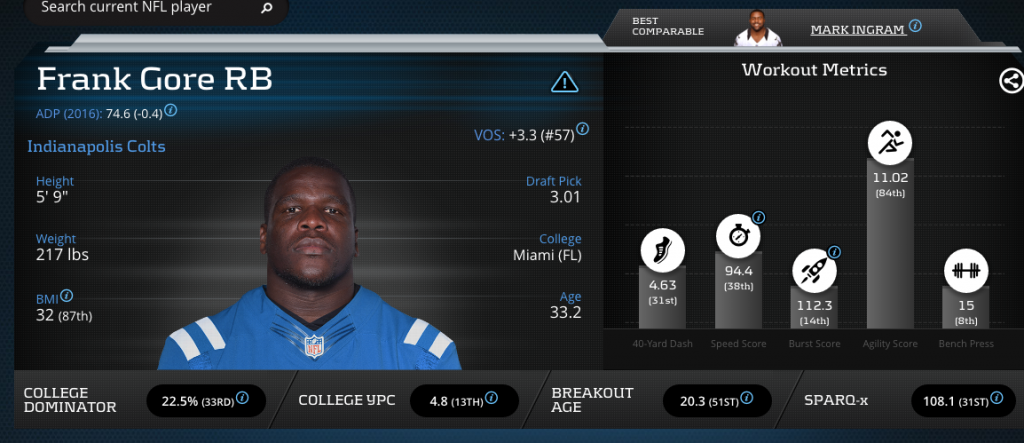
Frank Gore Advanced Metrics Profile
2) James Starks
I target James Starks in every draft, and almost always get him on my team. The investment is minimal (ADP 182.8), and reward could be great. Starks had four games of double digit fantasy points in standard leagues, and six in PPR leagues. He is a perfect streaming option and bye week replacement at running back. If Eddie Lacy is underwhelming or gets hurt? Look out.
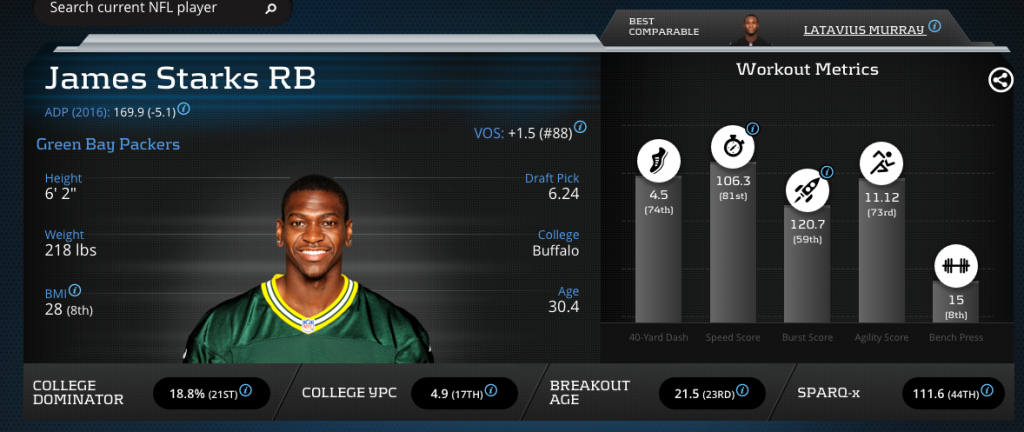
James Starks Advanced Metrics Profile
3) Tevin Coleman
It is all about opportunity for Tevin Coleman. Coleman won the starting job during the 2015 preseason and was the Falcons starting running back in week 1 last season. A 63.8-percent snap share means he sees the field when healthy. Combine that with Devonta Freeman’s 3.1 yards per carry from Week 9 on, and Coleman will be heavily involved this year. His ADP is currently 123.37 and Coleman is the No. 40 running back being drafted. That places him right around round 10, almost exactly where Freeman was drafted last year. Ironic.
Summary
Running backs are the only players that accumulate points for your team both on the ground and through the air. They will always be vitally important to your team’s success. But with the top running backs only scoring less than 250 points in 2015, the Zero RB theory is the best way to draft. Target the mid to late round running backs, and use Snap Share, Opportunity Share, and Production Premium to guide you to a fantasy championship.

